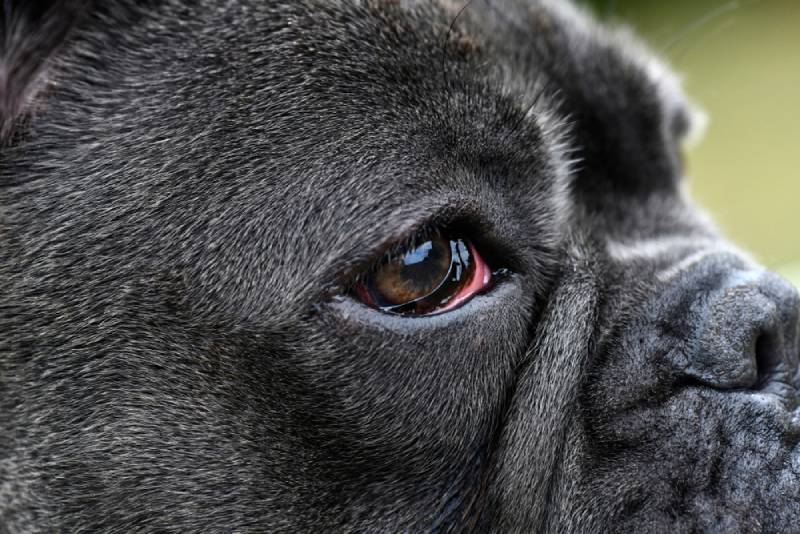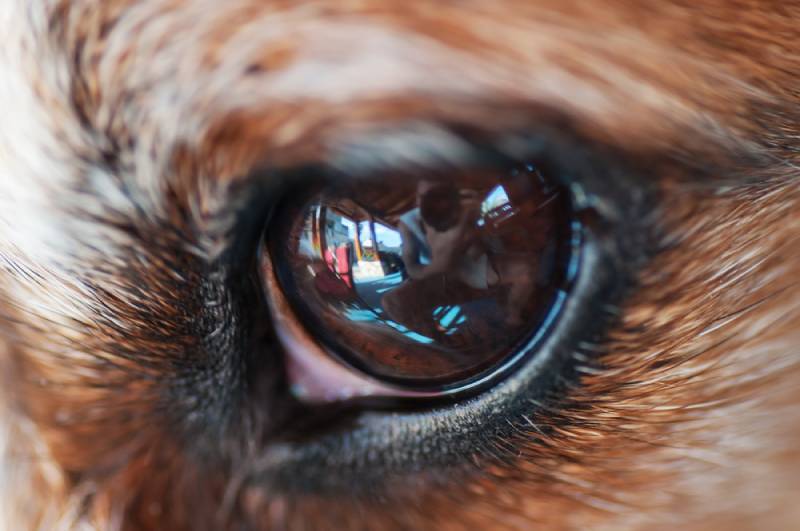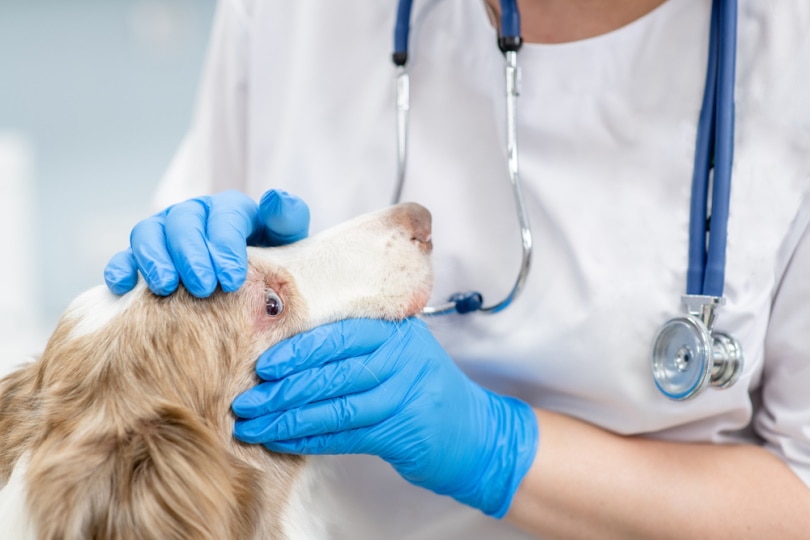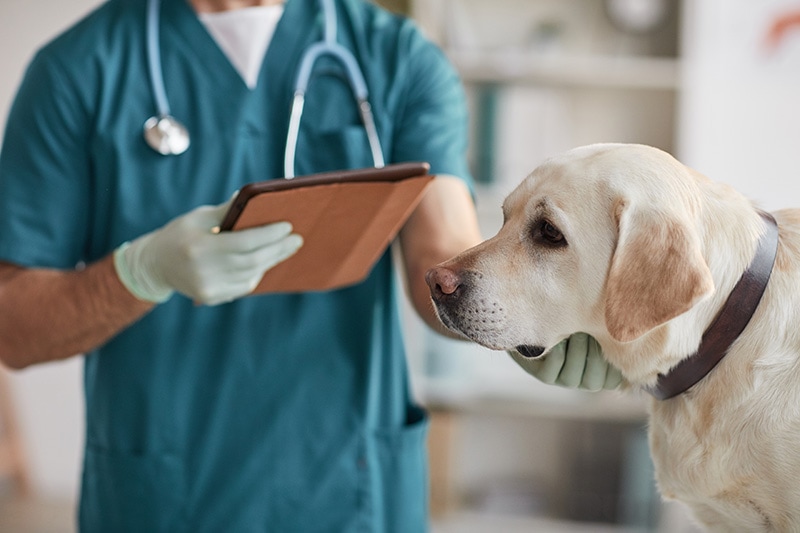Why Can I See My Dog’s Third Eyelid? Vet Approved Facts and FAQs

Updated on

Locking eyes with your dog is one of the most rewarding moments as a dog parent. However, while we read how they may feel, we may notice some physical attributes that were not there before. Perhaps this time, you noticed something extra in the corner of their eye.
It could be your dog’s third eyelid or nictitating membrane, which all dogs have. The third eyelid is always there but is not noticed because it is usually hidden. However, if it can be seen, it usually indicates something is wrong with the eye. If you can see your dog’s third eyelid, read on to figure out why.
Why Do Dogs Have a Third Eyelid?
Your dog has eyelids to protect their eyes, but dogs have a third one under the lower eyelid on the inner corner of the eye. It is also known as the nictitating membrane and has three parts, which include the following:
- The conjunctiva, which is a thin protective membrane
- T-shaped cartilage
- A tear gland held in place by the cartilage
A dog’s third eyelid and the other eyelids serve to protect the eyes in various ways, such as :
- Protection from being scratched, especially while walking or running.
- Keeps the eyes moist by spreading tears. Every time your dog blinks, the eyelids stimulate more tears while draining away the old ones. The third eyelid is responsible for 50% of a dog’s tears.
- Tears contain immunoglobulins to protect the eyes from infection.
- It removes any debris from the eye.

Why Can I See My Dog’s Third Eyelid?
In healthy, awake dogs, the third eyelid isn’t visible unless the dog is dozing off or suddenly waking up. If your dog’s third eyelid is visible for a prolonged period, they might suffer from an infection, cherry eye, neurological disorder, or poor physical health.
General Eye Problems
- Visibility of the third eyelid may indicate that the dog’s eyeball has sunken into its socket, frequently due to discomfort and inflammation.
- If your dog’s eyes are abnormally small due to a congenital abnormality, the third eye may be visible, or it can result from the eye shrinking due to a severe injury or inflammation.
- It is possible that the support system intended to keep the third eyelid in place deteriorated or is injured.
Cherry Eye
Cherry eye is the most common ailment in the third eyelid. It is the name given for a prolapsed gland that has moved out of its usual position. The gland that is now exposed may become swollen and red. Cherry eye is more common in some breeds than others. The connective tissues that hold the third eyelid gland in place may be weaker in some species; it is suspected that a genetic component is present in dogs with cherry eye.
While it may look unpleasant, cherry eye appears worse than what a dog feels. However, it can lead to more severe secondary problems, such as corneal ulcers and chronic dry eye.

Conjunctivitis
Conjunctivitis is also known as pink eye. While pink eye is commonly seen in humans, it can also occur in dogs. The third eyelid is made of the conjunctiva, and when this tissue becomes inflamed (conjunctivitis), the mucous membranes enlarge, become irritated, and change color to a brighter pink or red.
- Dry eye
- Allergies
- Trauma to the eye
- Debris or foreign objects, such as grass
- Virus
- Red eyes
- Squinting
- Excessive blinking
- Swelling around the eyes
- Discharge
Horner’s Syndrome
Horner’s Syndrome is a nerve disorder that affects the eye and facial muscles, causing the eye to droop, the eyelid to protrude, or the pupil to constrict. It usually happens on one side of the face, and the third eyelid may become more pronounced and inflamed. The causes of Horner’s syndrome are varied and typically unknown but can include a brain injury or tumor, infections, and spinal cord lesions.
Depending on how severe it is, Horner’s syndrome typically goes away on its own in a few weeks or months. However, it might be a sign of a more serious medical condition.
Poor health
The third eyelid can also be seen in malnourished, dehydrated, or underweight canines. When a dog is ill, the soft tissues behind the eye may contract, sinking the eye backward and making the third eyelid more visible.
How are Third Eyelid Issues Treated?
The primary cause for the visibility of a dog’s third eyelid will determine which treatment is needed, but treatment can often include:
- Flushing the eye to remove debris or using ophthalmic forceps to remove any foreign object
- Medications to treat infection
- Suturing of large cuts
- Surgery for cherry eye
Depending on the intensity of the operation, antibiotics and painkillers are likely to be part of the after-care regimen.

How to Care for Your Dog Eyelids
It is best to leave your dog’s eyelid alone unless there is an issue. Dogs with allergies and brachycephalic breeds are more susceptible to eyelid irritation, so it’s helpful to clean their eyes regularly. You can use a cotton ball with water to gently wipe your dog’s eyes, but never use chemicals or soap.
If you notice anything abnormal with your dog’s eyes, such as swelling, redness, discharge, color changes, or growths, you should have your veterinarian examine them as soon as possible.
Conclusion
All dogs have a third eyelid, which usually can’t be seen. If you can see your dog’s third eyelid, it is typically a sign of an eye issue or poor health. In severe cases, it will usually be inflamed or protruding.
The most common ailment regarding a dog’s third eyelid is cherry eye, which isn’t painful for your dog but can lead to secondary infections that may be more severe. Anytime you notice something out of the ordinary with your companion, it’s better to be safe than sorry and take your friend to the vet for a proper diagnosis.
Featured Image Credit By: Deborah Lee Rossiter, Shutterstock














